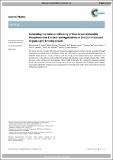Files in this item
Controlling the emission efficiency of blue-green iridium(III) phosphorescent emitters and applications in solution-processed organic light-emitting diodes
Item metadata
| dc.contributor.author | Sajjad, Muhammad T. | |
| dc.contributor.author | Sharma, Nidhi | |
| dc.contributor.author | Pal, Amlan K. | |
| dc.contributor.author | Hasan, Kamrul | |
| dc.contributor.author | Xie, Guohua | |
| dc.contributor.author | Kölln, Lisa S. | |
| dc.contributor.author | Hanan, Garry S. | |
| dc.contributor.author | Samuel, Ifor D. W. | |
| dc.contributor.author | Zysman-Colman, Eli | |
| dc.date.accessioned | 2017-08-30T23:32:10Z | |
| dc.date.available | 2017-08-30T23:32:10Z | |
| dc.date.issued | 2016-10-14 | |
| dc.identifier | 245890600 | |
| dc.identifier | a5163585-626b-4521-a52b-23c5221d9719 | |
| dc.identifier | 84989311454 | |
| dc.identifier | 000385386600011 | |
| dc.identifier.citation | Sajjad , M T , Sharma , N , Pal , A K , Hasan , K , Xie , G , Kölln , L S , Hanan , G S , Samuel , I D W & Zysman-Colman , E 2016 , ' Controlling the emission efficiency of blue-green iridium(III) phosphorescent emitters and applications in solution-processed organic light-emitting diodes ' , Journal of Materials Chemistry , vol. 4 , no. 38 , pp. 8939-8946 . https://doi.org/10.1039/C6TC02909D | en |
| dc.identifier.issn | 0959-9428 | |
| dc.identifier.other | Bibtex: urn:313f263f1c2548a7087088beac8d9c62 | |
| dc.identifier.other | ORCID: /0000-0001-7183-6022/work/56639059 | |
| dc.identifier.other | ORCID: /0000-0002-5677-5070/work/59464914 | |
| dc.identifier.uri | https://hdl.handle.net/10023/11577 | |
| dc.description | We are grateful to the European Research Council (grant 321305), EPSRC (grants EP/J01771X/1, EP/L017008/1 and EP/M02105X/1) for financial support. IDWS acknowledges a Royal Society Wolfson Research Merit Award. GSH thanks the Natural Sciences and Engineering Research Council (NSERC) of Canada for funding. | en |
| dc.description.abstract | We show that the emission efficiency of blue-green phosphorescent emitters can be controlled through coupling of the excited state to vibrational modes. We controlled this vibrational coupling through choice of different ligands and as a result, complexes with CF3-groups on the ancillary ligand were essentially non-emissive (ΦPL < 1%), whereas with isosteric CH3-groups the complexes were strongly emissive (ΦPL > 50%). Emission of the complexes can be drastically improved (30 times higher ΦPL compared to degassed solution for the CF3-containing complexes) by blending them with an inert solid host such as PMMA, which mitigates metal-ligand vibrations. Solution-processed organic light-emitting diodes made from these materials showed efficiency as high as 6.3%. | |
| dc.format.extent | 8 | |
| dc.format.extent | 6416988 | |
| dc.language.iso | eng | |
| dc.relation.ispartof | Journal of Materials Chemistry | en |
| dc.subject | QD Chemistry | en |
| dc.subject | DAS | en |
| dc.subject.lcc | QD | en |
| dc.title | Controlling the emission efficiency of blue-green iridium(III) phosphorescent emitters and applications in solution-processed organic light-emitting diodes | en |
| dc.type | Journal article | en |
| dc.contributor.sponsor | EPSRC | en |
| dc.contributor.sponsor | EPSRC | en |
| dc.contributor.sponsor | EPSRC | en |
| dc.contributor.sponsor | EPSRC | en |
| dc.contributor.institution | University of St Andrews. School of Physics and Astronomy | en |
| dc.contributor.institution | University of St Andrews. School of Chemistry | en |
| dc.contributor.institution | University of St Andrews. Organic Semiconductor Centre | en |
| dc.contributor.institution | University of St Andrews. Condensed Matter Physics | en |
| dc.contributor.institution | University of St Andrews. EaSTCHEM | en |
| dc.identifier.doi | 10.1039/C6TC02909D | |
| dc.description.status | Peer reviewed | en |
| dc.date.embargoedUntil | 2017-08-30 | |
| dc.identifier.grantnumber | EP/J01771X/1 | en |
| dc.identifier.grantnumber | ep/l017008/1 | en |
| dc.identifier.grantnumber | EP/M02105X/1 | en |
| dc.identifier.grantnumber | EP/K031252/1 | en |
This item appears in the following Collection(s)
Items in the St Andrews Research Repository are protected by copyright, with all rights reserved, unless otherwise indicated.

